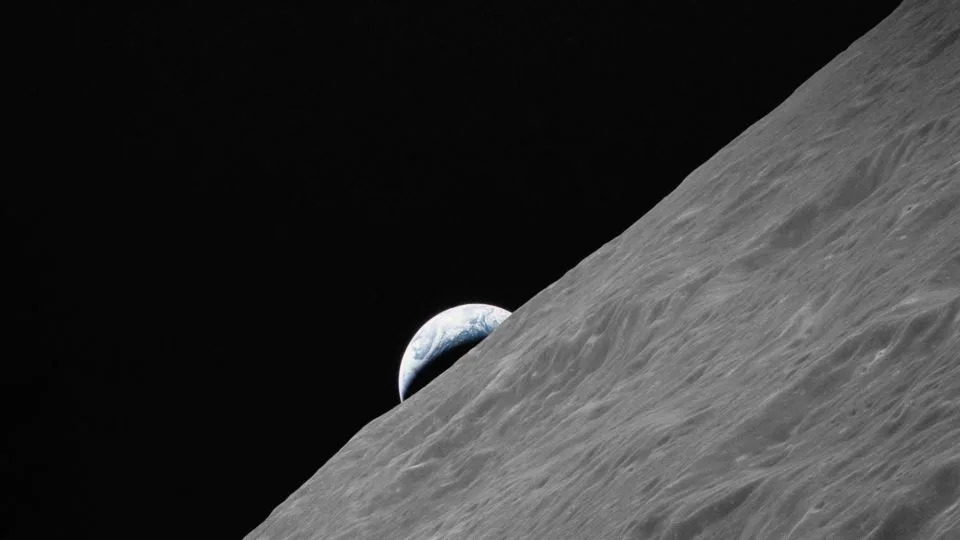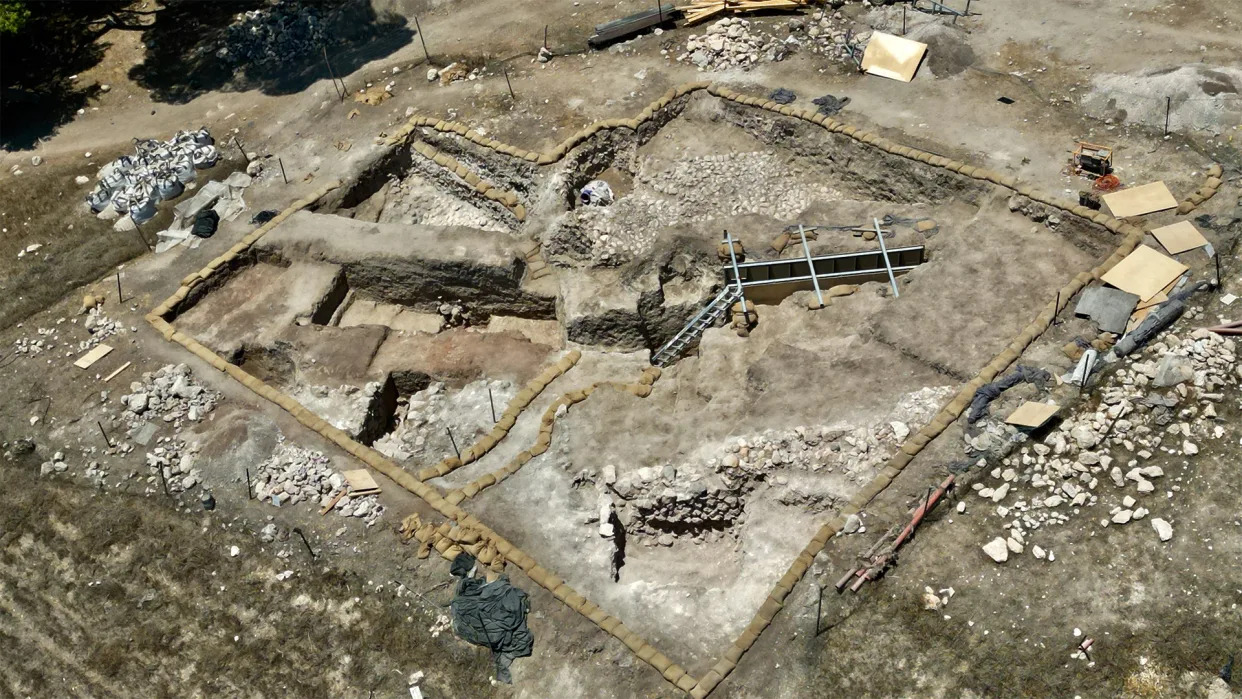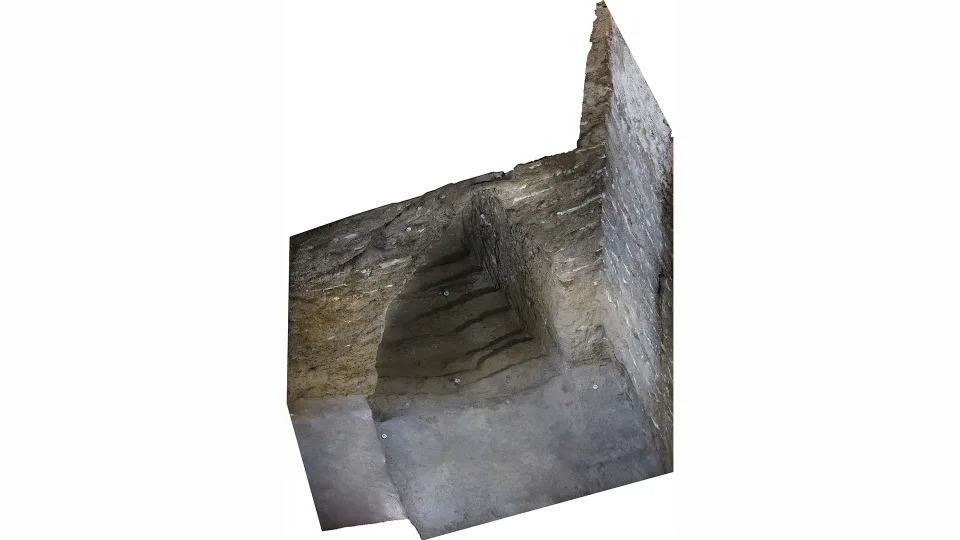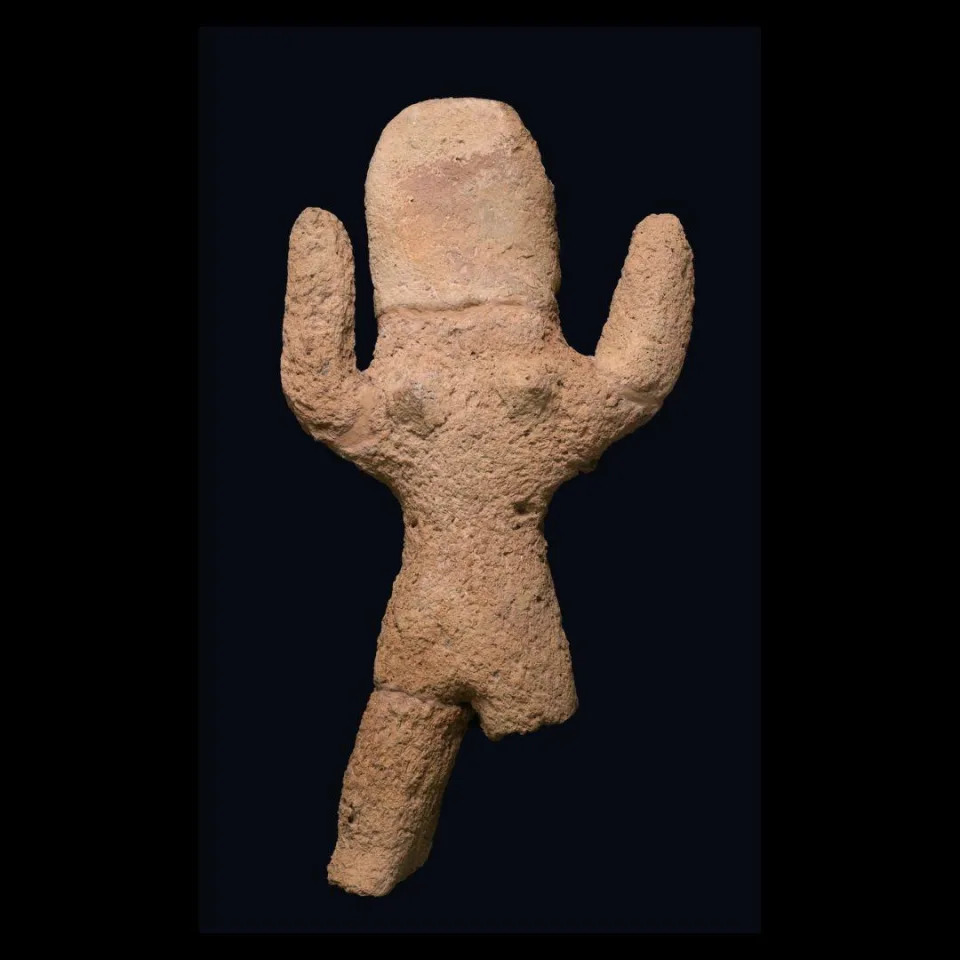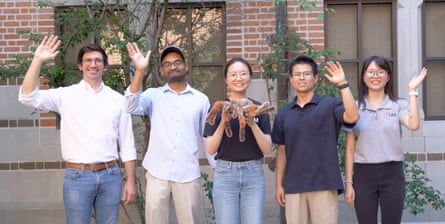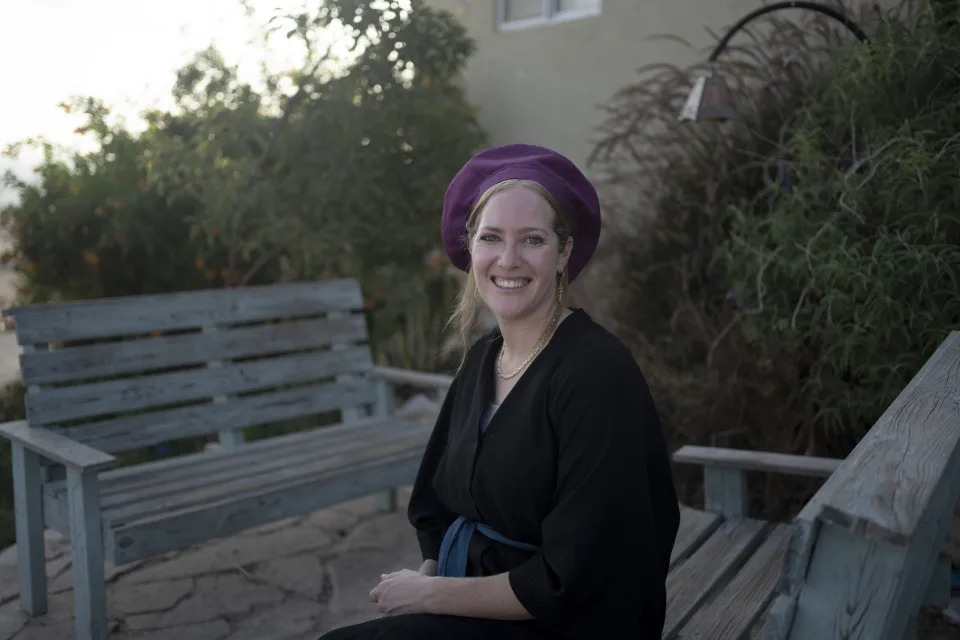Sharmila Kuthunur
Thu, September 14, 2023
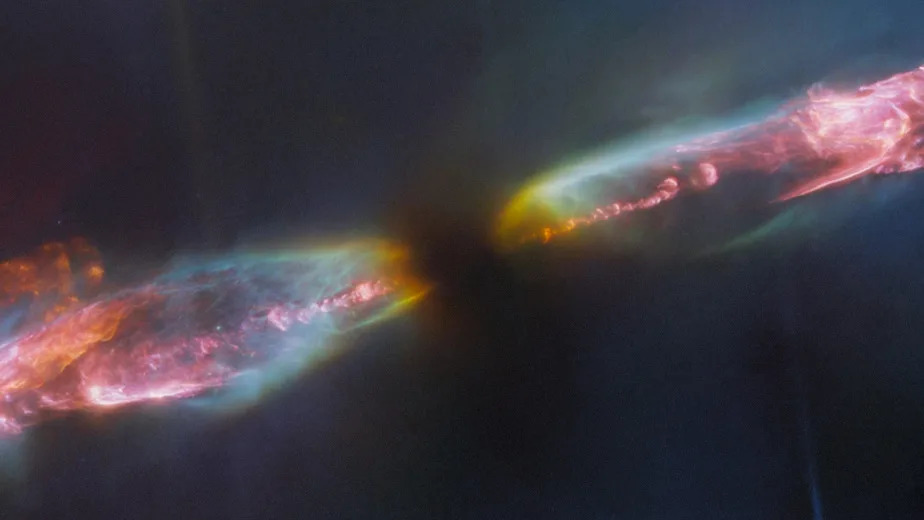
Against the dark backdrop of space, a vibrant, colorful view of jets making a diagonal line from the top right corner of the image to the bottom left.
It appears that some of the most powerful phenomena in the cosmos arise from its youngest inhabitants.
The latest cosmic eye candy, delivered by NASA's mighty James Webb Space Telescope (JWST) features jets of star matter blasting from the poles of a very young star and zipping through space at supersonic speeds.
The jets, which are together called Herbig-Haro 211 (HH 211), live in an energetic pocket of space located about 1,000 light-years away from Earth in the constellation Perseus. In this region, a protostar is actively sucking in surrounding gas and dust to grow larger, but is meanwhile shedding material into space in what astronomers call a bipolar outflow. And as those jets of material zoom through space, the JWST's sharp infrared eye managed to capture their interactions with interstellar matter as bright, colorful swirls.
The protostar (which is not seen in Webb's image) is suspected to be a binary star and likely represents what our sun used to be like when it was just a few tens of thousands years old with just 8% of its current mass. "It will eventually grow into a star like the sun," JWST representatives wrote in a statement published Thursday (Sept. 14).
Related: James Webb Space Telescope deepens major debate over universe's expansion rate
HH 211 is one of the youngest and nearest examples of a newer star spewing out matter, so it is an ideal object for the JWST to observe, researchers say. This telescope is unprecedented in its infrared capabilities, which is a game changer for stellar astronomers as it allows them to peer past thick blankets of gas and dust that envelope very young stars. Gaining such access to shrouded stellar bodies ultimately helps scientists decode the objects' chemical makeup and behavior.
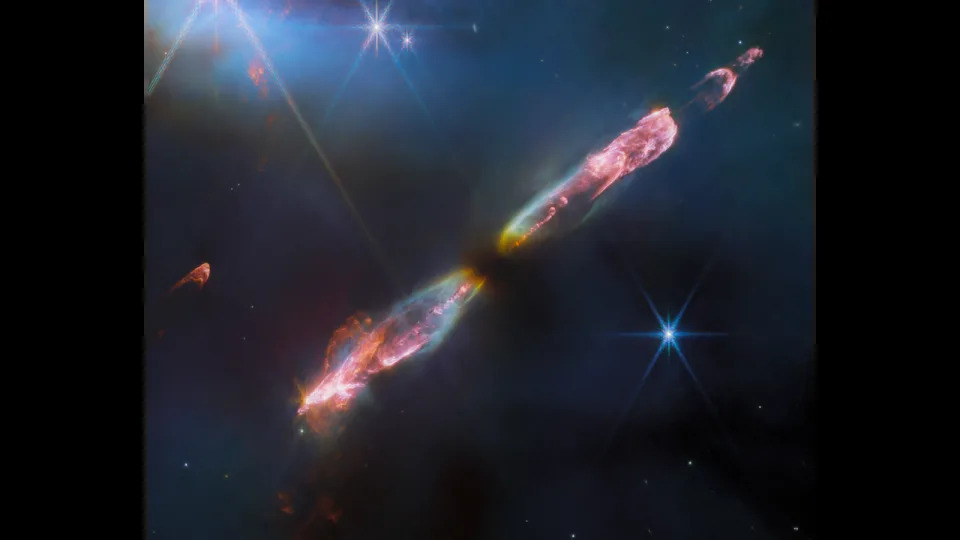
A full version of the image at the top, showing the jets spewing from a central region.
NASA's James Webb Space Telescope's high resolution, near-infrared look at Herbig-Haro 211 reveals exquisite detail of the outflow of a young star. (Image credit: ESA/Webb, NASA, CSA, Tom Ray (Dublin)
By studying data about HH 211, collected by the Near Infrared Spectrograph (NIRSpec) instrument onboard the JWST, researchers realized the jets from young stars are much slower and richer in molecules such as carbon monoxide, silicon monoxide and molecular hydrogen. This is in comparison to the faster jets that blast out of older stars. According to a recent study outlining the JWST's observations of HH 211, that's primarily because the shock waves surrounding the young star are not yet strong enough to shred the jets' molecules into individual atoms.
HH 211 belongs to a group of objects that have been known to evolve rapidly, with gas swirls vanishing only a few years after detection and new ones springing up in seemingly empty regions of space.
Hubble Space Telescope discovers 11-billion-year-old galaxy hidden in a quasar's glare
Robert Lea
Isaac Schultz
Thu, September 14, 2023
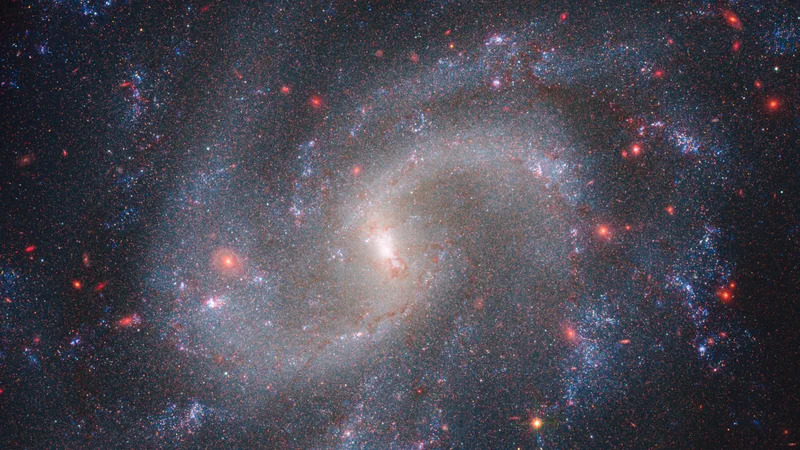
Combined Webb and Hubble Space Telescope data showing the galaxy NGC 5584, 72 million light-years away.
The rate of the universe’s expansion has vexed astronomers for decades. Called the Hubble constant, the figure is quite different depending on how you get to it—fittingly, a source of constant befuddlement to astrophysicists.
Now, a team of astronomers have calculated the expansion rate with greater precision using the Webb Space Telescope, a $10 billion space observatory launched in December 2021, and which has been making scientific observations at infrared wavelengths since July 2022. Using Webb data, the team managed to reduce the noise persistent in Hubble observational data of the stars that are used to measure the constant; the team’s research is currently hosted on the preprint server arXiv and are set to publish in The Astrophysical Journal.
In 2021, a different group of researchers recalculated the Hubble constant in order to find a newly precise age of the universe: 13.77 billion years old.
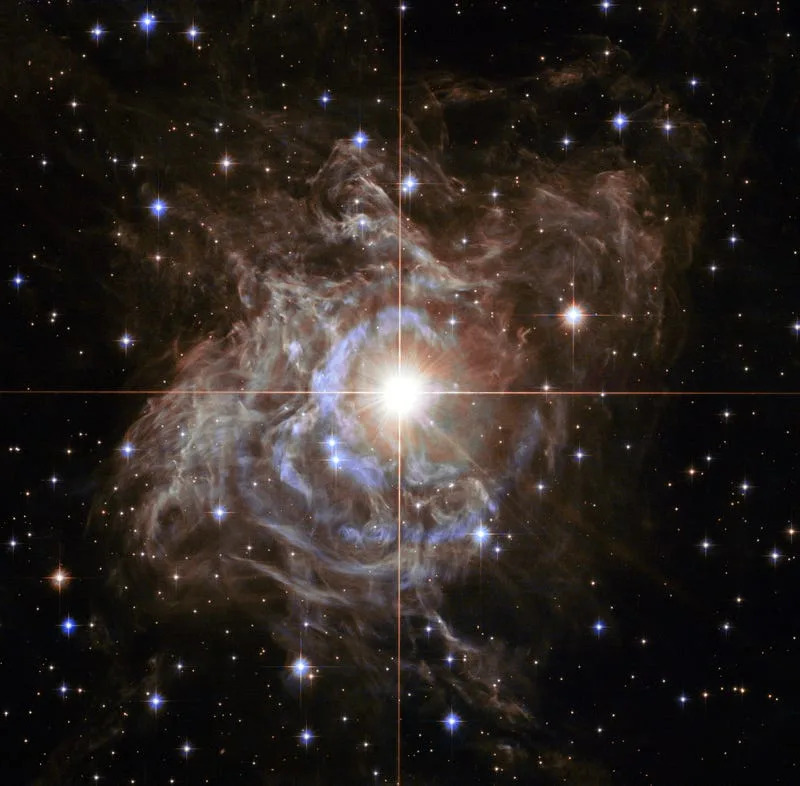
A Hubble image of the Cepheid variable star RS Puppis.
Though observations of the Cepheids by the Hubble Space Telescope significantly improved scientists’ estimates of the universe’s expansion, Webb’s observations of the Cepheids at near-infrared wavelengths meant that the newer telescope could distinguish light from the Cepheids from the light of neighboring stars with greater ease. Ergo, a less noisy measurement of the Hubble constant, and its tension.
In October 2022, a different team heightened the certainty of the Hubble tension to a 5-sigma threshold, meaning that the discrepancy in the two rates only has a one-in-a-million chance of being a statistical fluke.
It’s entirely possible—and arguably a more mouth-watering premise—that astronomers are missing a piece of the cosmological puzzle. According to Riess’ blog post, it could be “the presence of exotic dark energy, exotic dark matter, a revision to our understanding of gravity, or the presence of a unique particle or field.” Or, of course, an accumulation of errors. But the new research affirms that the tension remains, uh, very taut.
The findings are also a vindication of the Hubble Space Telescope, which evidently took the best data it could with the technology it has. But Webb is a helpful auditor of its work, and other observations—like the soon-operational Rubin Observatory, and its Legacy Survey of Space and Time Camera—could yet clarify the nature of our universe’s expansion.
Robert Lea
SPACE.COM
Thu, September 14, 2023
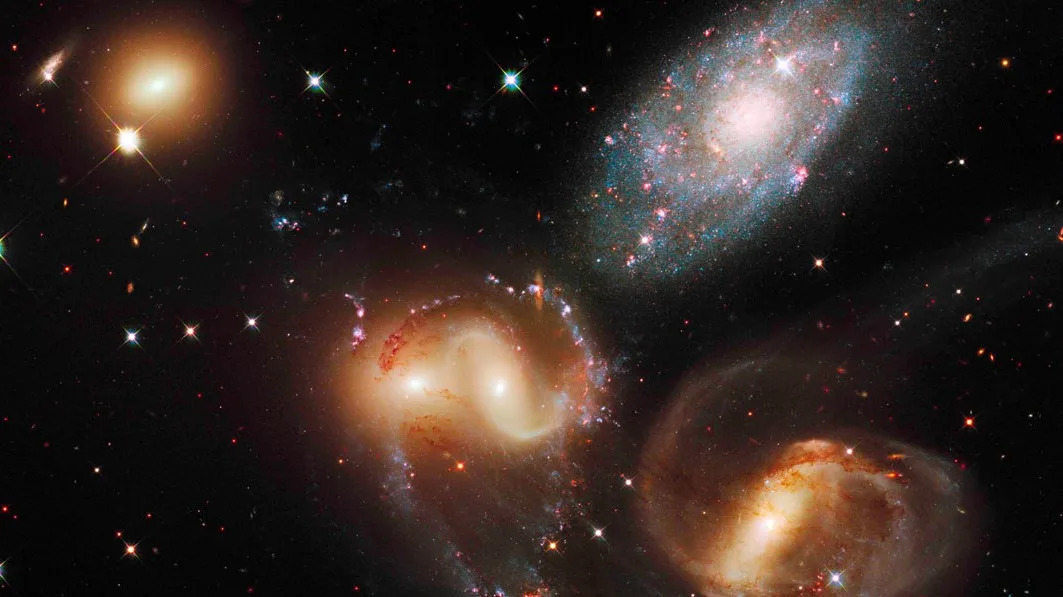
separate large galaxies shine alongside bright stars and other, distant galaxies.
Using the Hubble Space Telescope, a team of astronomers has used a tricky technique to discover an elusive 11-billion-year-old galaxy. Rather than observe the light this realm emits, they watched for the light it absorbs.
Just as we see a light bulb via the light it emits, astronomers usually observe galaxies using the light their stars emit. Galaxies put out light waves found across the entire electromagnetic spectrum, and different telescopes are able to observe these cosmic objects in different wavelengths of light to form a full picture.
But, when a galaxy is located along the same line of sight as another, more distant, source of bright light, there's another way to go about these galactic observations. As light passes through a background galaxy toward a foreground galaxy, for instance, gas and dust in the foreground galaxy will absorb some of the background one's wavelengths. And because chemical elements absorb light at specific wavelengths, looking for gaps in the light output — or spectra — from a background source can tell astronomers what that light had passed through on its way to our telescopes. In other words, light in those "gaps" would've been absorbed by a foreground object on the way to our vantage point.
One potentially useful background source for this technique are quasars, which are extremely bright galactic hearts powered by supermassive black holes blasting out jets of radiation and matter as they feast on surrounding material.
"To find absorbing galaxies, we first look for quasars that are particularly red," Johan Fynbo, an astronomer at the Cosmic Dawn Center, said in a statement. "Because star dust tends to absorb the blue light but not the red, if there is a dusty galaxy in the foreground, the quasar will be reddened."
He and his team have spotted several absorbing galaxies by parsing light from reddened quasars, but once this is done, they are faced with a much more challenging task: hunting for light emitted by the absorbing galaxy itself.
A firefly on a cosmic lighthouse
When situated exactly behind a galaxy, quasars tend to disrupt our view of foreground galaxies because they are so immensely bright. So much so that they essentially overwhelm the combined light of every star in an entire galaxy.
This makes spotting an absorbing galaxy with its own light output akin to trying to spot a firefly perched on the lamp of a lighthouse while standing onshore. While this might prove too intimidating a challenge for many, however, Fynbo and colleagues relish it.
Unfortunately, the scientists haven’t yet identified the light coming from their recently-uncovered, 11-billion-year-old absorbing galaxy, but the absorption patterns this object has revealed are remarkable. The galaxy, seen as it was when our 13.8 billion-year-old universe was only around 3 billion years old, is absorbing more light than other galaxies found in a similar fashion, meaning it is likely a more mature galaxy such as the Milky Way.
"The features that we found in the missing light tell us something about the dust in the foreground galaxy," Lise Christensen, a member of the discovery team and an astronomer at the Cosmic Dawn Center, said in the statement. "In fact, the dust seems to resemble the dust that we see locally in the Milky Way and one of our neighboring galaxies."
The team was also able to determine that the galaxy has a bright counterpart. That galaxy, which seems to be birthing stars at an intense rate, is so close to the absorber galaxy that the team also believes the two are probably gravitationally bound. This means ,at some point after they were noticed, the two galaxies likely formed a galaxy group similar to the local group in which the Milky Way sits.
Fynbo intends to revisit this region of space with other instruments, including the Nordic Optical Telescope at La Palma, to search for other members of this galactic group in the hope he will be able to see the absorbing galaxy emit light of its own.
"This makes the galaxies even more interesting to study," the astronomer concluded.
The team’s research has been accepted for publication in the journal Astronomy & Astrophysics. Meanwhile, a pre-peer review version is available on the research repository arXiv.
Thu, September 14, 2023

separate large galaxies shine alongside bright stars and other, distant galaxies.
Using the Hubble Space Telescope, a team of astronomers has used a tricky technique to discover an elusive 11-billion-year-old galaxy. Rather than observe the light this realm emits, they watched for the light it absorbs.
Just as we see a light bulb via the light it emits, astronomers usually observe galaxies using the light their stars emit. Galaxies put out light waves found across the entire electromagnetic spectrum, and different telescopes are able to observe these cosmic objects in different wavelengths of light to form a full picture.
But, when a galaxy is located along the same line of sight as another, more distant, source of bright light, there's another way to go about these galactic observations. As light passes through a background galaxy toward a foreground galaxy, for instance, gas and dust in the foreground galaxy will absorb some of the background one's wavelengths. And because chemical elements absorb light at specific wavelengths, looking for gaps in the light output — or spectra — from a background source can tell astronomers what that light had passed through on its way to our telescopes. In other words, light in those "gaps" would've been absorbed by a foreground object on the way to our vantage point.
One potentially useful background source for this technique are quasars, which are extremely bright galactic hearts powered by supermassive black holes blasting out jets of radiation and matter as they feast on surrounding material.
"To find absorbing galaxies, we first look for quasars that are particularly red," Johan Fynbo, an astronomer at the Cosmic Dawn Center, said in a statement. "Because star dust tends to absorb the blue light but not the red, if there is a dusty galaxy in the foreground, the quasar will be reddened."
He and his team have spotted several absorbing galaxies by parsing light from reddened quasars, but once this is done, they are faced with a much more challenging task: hunting for light emitted by the absorbing galaxy itself.
A firefly on a cosmic lighthouse
When situated exactly behind a galaxy, quasars tend to disrupt our view of foreground galaxies because they are so immensely bright. So much so that they essentially overwhelm the combined light of every star in an entire galaxy.
This makes spotting an absorbing galaxy with its own light output akin to trying to spot a firefly perched on the lamp of a lighthouse while standing onshore. While this might prove too intimidating a challenge for many, however, Fynbo and colleagues relish it.
Unfortunately, the scientists haven’t yet identified the light coming from their recently-uncovered, 11-billion-year-old absorbing galaxy, but the absorption patterns this object has revealed are remarkable. The galaxy, seen as it was when our 13.8 billion-year-old universe was only around 3 billion years old, is absorbing more light than other galaxies found in a similar fashion, meaning it is likely a more mature galaxy such as the Milky Way.
"The features that we found in the missing light tell us something about the dust in the foreground galaxy," Lise Christensen, a member of the discovery team and an astronomer at the Cosmic Dawn Center, said in the statement. "In fact, the dust seems to resemble the dust that we see locally in the Milky Way and one of our neighboring galaxies."
The team was also able to determine that the galaxy has a bright counterpart. That galaxy, which seems to be birthing stars at an intense rate, is so close to the absorber galaxy that the team also believes the two are probably gravitationally bound. This means ,at some point after they were noticed, the two galaxies likely formed a galaxy group similar to the local group in which the Milky Way sits.
Fynbo intends to revisit this region of space with other instruments, including the Nordic Optical Telescope at La Palma, to search for other members of this galactic group in the hope he will be able to see the absorbing galaxy emit light of its own.
"This makes the galaxies even more interesting to study," the astronomer concluded.
The team’s research has been accepted for publication in the journal Astronomy & Astrophysics. Meanwhile, a pre-peer review version is available on the research repository arXiv.
Webb Telescope Data Confirms ‘Hubble Tension’ Is Not Hubble Telescope’s Fault
Isaac Schultz
Thu, September 14, 2023

Combined Webb and Hubble Space Telescope data showing the galaxy NGC 5584, 72 million light-years away.
The rate of the universe’s expansion has vexed astronomers for decades. Called the Hubble constant, the figure is quite different depending on how you get to it—fittingly, a source of constant befuddlement to astrophysicists.
Now, a team of astronomers have calculated the expansion rate with greater precision using the Webb Space Telescope, a $10 billion space observatory launched in December 2021, and which has been making scientific observations at infrared wavelengths since July 2022. Using Webb data, the team managed to reduce the noise persistent in Hubble observational data of the stars that are used to measure the constant; the team’s research is currently hosted on the preprint server arXiv and are set to publish in The Astrophysical Journal.
In 2021, a different group of researchers recalculated the Hubble constant in order to find a newly precise age of the universe: 13.77 billion years old.

A Hubble image of the Cepheid variable star RS Puppis.
Though observations of the Cepheids by the Hubble Space Telescope significantly improved scientists’ estimates of the universe’s expansion, Webb’s observations of the Cepheids at near-infrared wavelengths meant that the newer telescope could distinguish light from the Cepheids from the light of neighboring stars with greater ease. Ergo, a less noisy measurement of the Hubble constant, and its tension.
In October 2022, a different team heightened the certainty of the Hubble tension to a 5-sigma threshold, meaning that the discrepancy in the two rates only has a one-in-a-million chance of being a statistical fluke.
It’s entirely possible—and arguably a more mouth-watering premise—that astronomers are missing a piece of the cosmological puzzle. According to Riess’ blog post, it could be “the presence of exotic dark energy, exotic dark matter, a revision to our understanding of gravity, or the presence of a unique particle or field.” Or, of course, an accumulation of errors. But the new research affirms that the tension remains, uh, very taut.
The findings are also a vindication of the Hubble Space Telescope, which evidently took the best data it could with the technology it has. But Webb is a helpful auditor of its work, and other observations—like the soon-operational Rubin Observatory, and its Legacy Survey of Space and Time Camera—could yet clarify the nature of our universe’s expansion.
Gizmodo
James Webb telescope sees potential signs of alien life in the atmosphere of a distant 'Goldilocks' water world
Harry Baker
Thu, September 14, 2023

A blue planet with a distant red star in the background
Earlier this week, Live Science reported that NASA's James Webb Space Telescope (JWST) could likely detect signs of extraterrestrial life on an Earth-like planet up to 50 light-years away. Now, a new study reveals that the state-of-the-art spacecraft may have already spotted one such hint of life — "alien farts" — in the atmosphere of a potentially ocean-covered "Goldilocks" world more than twice as far away.
The exoplanet in question, K2-18 b, is a sub-Neptune planet (between the size of Earth and Neptune) that orbits in the habitable zone around a red dwarf star roughly 120 light-years from the sun. K2-18 b, which is around 8.6 times more massive than our planet and around 2.6 times as wide, was first discovered by NASA's Kepler telescope in 2015. And in 2018, NASA's Hubble telescope discovered water in the exoplanet's atmosphere.
In the new study, which was uploaded to the pre-print server arXiv on Sept. 11 (and will be published in a forthcoming issue of The Astrophysical Journal Letters), researchers used JWST to further analyze light that had passed through K2-18 b's atmosphere.
The resulting atmospheric spectrum, which is the most detailed of its kind ever to be captured from a habitable sub-Neptune planet, shows that the exoplanet's atmosphere contains large amounts of hydrogen, methane and carbon dioxide, and low levels of ammonia. Those chemical markers suggest that K2-18 b could be a hycean world — an exoplanet with a hydrogen-rich atmosphere and a water ocean covering an icy mantle.

A red sun appears rises above an alien ocean
Hycean worlds are a prime candidate to harbor extraterrestrial life. However, even if K2-18 b does have an ocean, there is no guarantee that it would be suitable for life: It may be too hot to support life or lack the required nutrients and chemicals to spark life.
Researchers also detected what they believe are traces of dimethyl sulfide (DMS), a foul-smelling chemical that is only known to be produced by microscopic life in Earth's oceans.
DMS is primarily emitted by phytoplankton, or photosynthetic algae, in Earth's oceans. It is made from sulfur, carbon and hydrogen and is the most abundant organic form of sulfur in Earth's atmosphere, which makes it one of the key biosignatures, or signs of biological life, on our planet.
However, the evidence of DMS "requires further validation," researchers wrote in a statement. It is also possible that some unknown geological process could produce the chemical instead of biological life, they added.
Related: Humans will never live on an exoplanet, Nobel Laureate says
Regardless of whether or not K2-18 b does harbor alien lifeforms, the results of the new study further highlight that Hycean worlds may be ideal places to look for extraterrestrial life.

Swirling algal bloom off the coast of a peninsula
"Traditionally, the search for life on exoplanets has focused primarily on smaller rocky planets, but the larger Hycean worlds are significantly more conducive to atmospheric observations," study lead author Nikku Madhusudhan, an astrophysicist and exoplanetary scientist at the University of Cambridge in England, said in the statement.
It is unclear how many Hycean worlds there are but "sub-Neptunes are the most common type of planet known so far in the galaxy," study co-author Subhajit Sarkar, an astrophysicist at Cardiff University in Wales, said in the statement.
The study also highlights the incredible power of JWST compared to predecessors like Hubble and Kepler, the researchers added.
"This result was only possible because of the extended wavelength range and unprecedented sensitivity of JWST," Madhusudhan said. The Hubble telescope would have required at least eight times as many observations of K2-18 b to acquire the same level of detail, he added.
The researchers are planning to use JWST to take another look at K2-18 b in the future to see if the telescope can find any more evidence of extraterrestrial life on the exoplanet. If it does, it "would transform our understanding of our place in the universe," Madhusudhan said.
Harry Baker
Thu, September 14, 2023

A blue planet with a distant red star in the background
Earlier this week, Live Science reported that NASA's James Webb Space Telescope (JWST) could likely detect signs of extraterrestrial life on an Earth-like planet up to 50 light-years away. Now, a new study reveals that the state-of-the-art spacecraft may have already spotted one such hint of life — "alien farts" — in the atmosphere of a potentially ocean-covered "Goldilocks" world more than twice as far away.
The exoplanet in question, K2-18 b, is a sub-Neptune planet (between the size of Earth and Neptune) that orbits in the habitable zone around a red dwarf star roughly 120 light-years from the sun. K2-18 b, which is around 8.6 times more massive than our planet and around 2.6 times as wide, was first discovered by NASA's Kepler telescope in 2015. And in 2018, NASA's Hubble telescope discovered water in the exoplanet's atmosphere.
In the new study, which was uploaded to the pre-print server arXiv on Sept. 11 (and will be published in a forthcoming issue of The Astrophysical Journal Letters), researchers used JWST to further analyze light that had passed through K2-18 b's atmosphere.
The resulting atmospheric spectrum, which is the most detailed of its kind ever to be captured from a habitable sub-Neptune planet, shows that the exoplanet's atmosphere contains large amounts of hydrogen, methane and carbon dioxide, and low levels of ammonia. Those chemical markers suggest that K2-18 b could be a hycean world — an exoplanet with a hydrogen-rich atmosphere and a water ocean covering an icy mantle.

A red sun appears rises above an alien ocean
Hycean worlds are a prime candidate to harbor extraterrestrial life. However, even if K2-18 b does have an ocean, there is no guarantee that it would be suitable for life: It may be too hot to support life or lack the required nutrients and chemicals to spark life.
Researchers also detected what they believe are traces of dimethyl sulfide (DMS), a foul-smelling chemical that is only known to be produced by microscopic life in Earth's oceans.
DMS is primarily emitted by phytoplankton, or photosynthetic algae, in Earth's oceans. It is made from sulfur, carbon and hydrogen and is the most abundant organic form of sulfur in Earth's atmosphere, which makes it one of the key biosignatures, or signs of biological life, on our planet.
However, the evidence of DMS "requires further validation," researchers wrote in a statement. It is also possible that some unknown geological process could produce the chemical instead of biological life, they added.
Related: Humans will never live on an exoplanet, Nobel Laureate says
Regardless of whether or not K2-18 b does harbor alien lifeforms, the results of the new study further highlight that Hycean worlds may be ideal places to look for extraterrestrial life.

Swirling algal bloom off the coast of a peninsula
"Traditionally, the search for life on exoplanets has focused primarily on smaller rocky planets, but the larger Hycean worlds are significantly more conducive to atmospheric observations," study lead author Nikku Madhusudhan, an astrophysicist and exoplanetary scientist at the University of Cambridge in England, said in the statement.
It is unclear how many Hycean worlds there are but "sub-Neptunes are the most common type of planet known so far in the galaxy," study co-author Subhajit Sarkar, an astrophysicist at Cardiff University in Wales, said in the statement.
The study also highlights the incredible power of JWST compared to predecessors like Hubble and Kepler, the researchers added.
"This result was only possible because of the extended wavelength range and unprecedented sensitivity of JWST," Madhusudhan said. The Hubble telescope would have required at least eight times as many observations of K2-18 b to acquire the same level of detail, he added.
The researchers are planning to use JWST to take another look at K2-18 b in the future to see if the telescope can find any more evidence of extraterrestrial life on the exoplanet. If it does, it "would transform our understanding of our place in the universe," Madhusudhan said.
James Webb Space Telescope deepens major debate over universe's expansion rate
Monisha Ravisetti
Wed, September 13, 2023
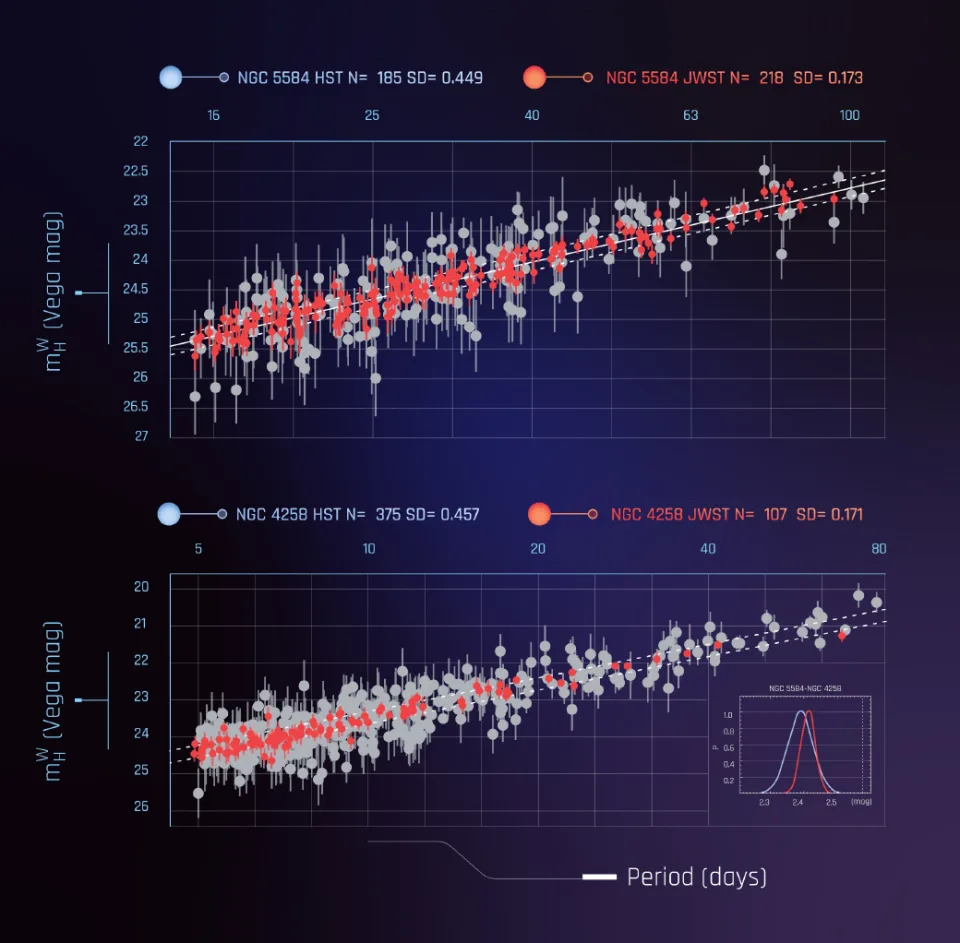
Comparison of Cepheid period-luminosity relations used to measure distances. The red points are from Webb and the gray points are from Hubble. The top panel is for NGC 5584, the Type Ia supernova host, with the inset showing image stamps of the same Cepheid seen by each telescope. The bottom panel is for NGC 4258, a galaxy with a known, geometric distance, with the inset showing the difference in distance moduli between NGC 5584 and NGC 4258 as measured with each telescope.
'I have your back, Hubble,' said the JWST (probably)
Hubble is a key device used in resolving Hubble tension because it's able to measure stellar brightnesses with incredible precision. That's because it sits above Earth's blurring atmosphere, unlike ground-based observatories hampered by our planet's hazy shield.
Such brightnesses can tell us how far away those stars are and, because we know the immutable speed of light, for how long that light has been traveling to reach us. After some calculations, scientists reason that this kind of information taken from lots (and lots) of stars should help us figure out the Hubble constant.
"Prior to Hubble’s 1990 launch," Riess explained, "the expansion rate of the universe was so uncertain astronomers weren’t sure if the universe has been expanding for 10 billion or 20 billion years."
Furthermore, there is one star in particular that scientists like to focus on with Hubble to tease out the universe's expansion rate: Cepheids. These are supergiant stars with something like 100,000 times the luminosity of our sun.
"They are the gold standard tool for the purpose of measuring the distances of galaxies a hundred million or more light-years away," Riess said, calling such measurements "a crucial step to determine the Hubble constant."
Riess also mentioned that Cepheids pulsate — expand and contract in size — which indicates their relative luminosities. The longer the period, he explained, the intrinsically brighter they are – and this is good because it provides baseline brightnesses and ultimately more accurate measurements.
So, thanks to Hubble's perch above our atmosphere, the telescope can identify individual Cepheids in galaxies more than a hundred million light-years away, thus measuring the time interval over which these galaxies change their brightness.
But Hubble has its limitations.
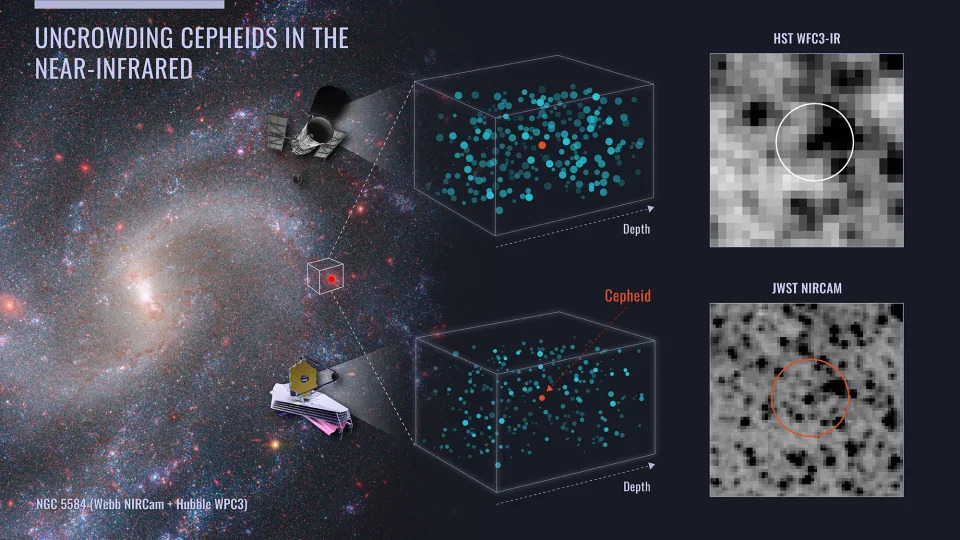
This diagram illustrates the combined power of the Hubble and Webb space telescopes in nailing down precise distances to a special class of variable star that is used in calibrating the expansion rate of the universe. These Cepheid variable stars are seen in crowded star fields. Light contamination from surrounding stars may make the measurement of the brightness of a Cepheid less precise. Webb’s sharper infrared vision allows for a Cepheid target to be more clearly isolated from surrounding stars, as seen in the right side of the diagram. The Webb data confirms the accuracy of 30 years of Hubble observations of Cepheids that were critical in establishing the bottom rung of the cosmic distance ladder for measuring the universe’s expansion rate.More
It's not quite sensitive enough to infrared light wavelengths, which are found beyond the red end of the electromagnetic spectrum and remain invisible to human eyes. "Unfortunately," Riess said, "Hubble’s red-light vision is not as sharp as its blue, so the Cepheid starlight we see there is blended with other stars in its field of view."
Infrared vision is important when peering at faraway objects because, first of all, light coming from distant sources gets stretched out on the way to our vantage point on Earth. Once-tight bluish wavelengths turn into longer, reddish ones. That's actually where the term "redshifted galaxies" comes from, referring to realms falling deeper toward that end of the spectrum from our ground-based perspective.
And second, only infrared light has the ability to pass through dust unscathed, meaning if a Cepheid is stuck behind a shroud of interstellar matter, it'd appear fainter to us. That runs the risk of its light blending in with light from another Cepheid in the vicinity, for instance, or making it seem like a star is farther away than it truly is.
"We can account for the average amount of blending, statistically, the same way a doctor figures out your weight by subtracting the average weight of clothes from the scale reading," Riess said. "But doing so adds noise to the measurements. Some people’s clothes are heavier than others."
Enter the James Webb Space Telescope.
This $10 billion observatory, sitting nearly 1 million miles (1.6 million kilometers) away from Earth, is built to unveil the infrared universe to us.
"In the first year of Webb operations with our General Observers program 1685, we collected observations of Cepheids found by Hubble at two steps along what’s known as the cosmic distance ladder," Riess said.
The first step, according to the team, involved observing Cepheids in a galaxy with a known geometric distance for calibration purposes. That galaxy was NGC 4258. The second step was to observe Cepheids in the host galaxies of recent Type Ia supernovas, which are bright star explosions, to basically double check whether Hubble's observations were right. If Hubble was wrong, well, maybe we finally learned why there's a discrepancy.
But Hubble's observations were right.
"JWST, I think, has really kind of put a nail in the coffin of: Was there a problem with Hubble's Cepheid measurements?" Riess said while presenting the research at the JWST's First Year of Science conference on Tuesday.
But notably, the Nobel Laureate researcher does not exactly see this as the crisis it's gradually deemed itself.
"I don't care what the value of the Hubble constant comes out to be," he said during the conference. "I want to understand why our best tools — our gold standard tools — are not agreeing with each other."
A study on these results was posted last month on the pre-print database arXiv. That study has not yet been peer-reviewed.
Monisha Ravisetti
Wed, September 13, 2023
THE CONVERSATION
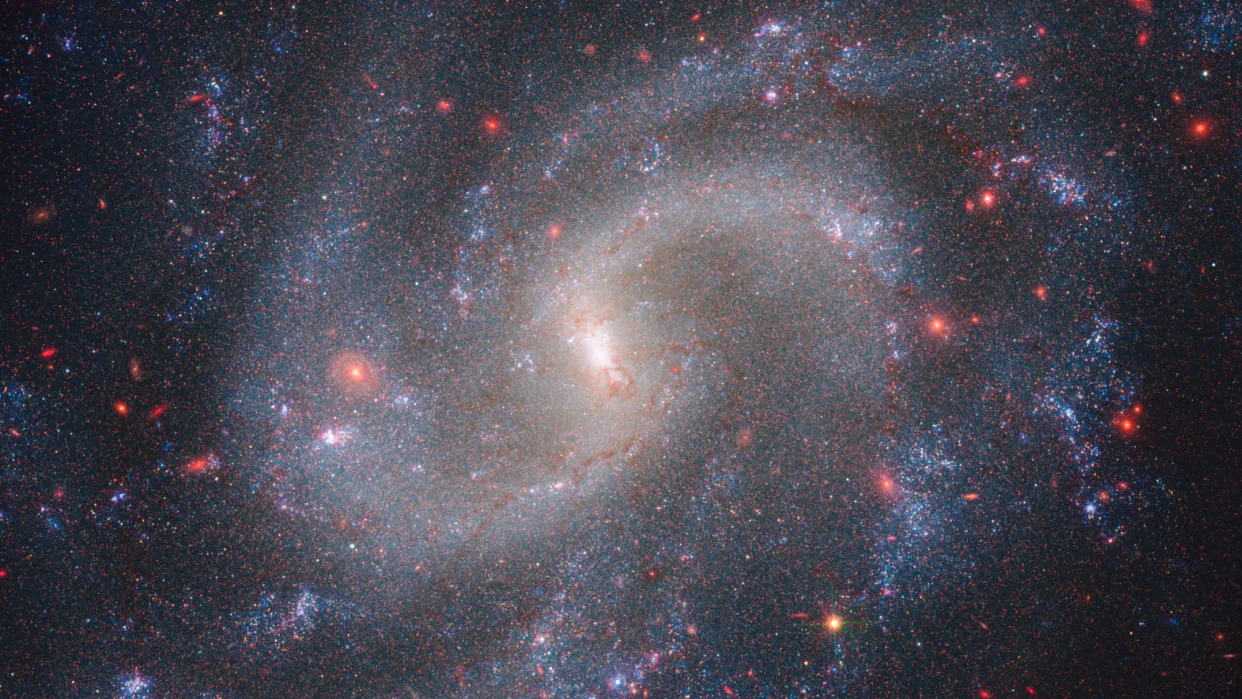
A large galaxy takes up the entirety of the image. The galaxy has a bright white core, and several large spiral arms extending out from that core, rotating clockwise. The arms are light blue with many pink speckles and clumps littering the arms. The background is also filled with a smattering of white and pink dots.
One of the biggest and most heated cosmic debates of our time surrounds a peculiar dilemma with a rather snappy name: Hubble tension.
This phrase describes the fact that, even though scientists are aware the cosmos is constantly ballooning outward in every direction — as we can clearly see stars and galaxies drifting farther and farther away from us over time — they can't perfectly pin down the rate at which that ballooning is happening. (And the rate is accelerating, by the way, a startling discovery astronomers made in the late 1990s that could be due in part to the existence of dark energy.)
That leaves us with a pretty major chasm in our understanding of the universe.
In an attempt to get to the bottom of this, on Tuesday (Sept. 12) researchers announced that the James Webb Space Telescope (JWST) has weighed in on the situation for the first time – but it did not solve the mystery. In fact, JWST actually thickened it.
But first, let's talk about how we got here.
Related: Exoplanet's surface may be covered in oceans, James Webb Space Telescope finds
So, what's the problem with calculating the rate?
Basically, settling Hubble tension once and for all is dependent on resolving the true value of the Hubble constant, which is a crucial number in calculating the universe's expansion rate. Yet, for whatever reason, our theoretical predictions of the constant do not appear to match up with reality.
According to most models, the Hubble constant should equal something around 68 kilometers per second per megaparsec (km/s/Mpc). One megaparsec is 1,000 parsecs, or about 3,260 light-years, for context. But after scanning stars and galaxies across our universe, some experts calculate the constant to be 69.8 km/s/Mpc, while others find it to be as high as 74 km/s/Mpc, depending on the method of measurement. Still others have suggested solutions that fall between the two.
Potentially, this discrepancy either suggests our instruments are not intelligent enough — or maybe we're awfully wrong about that theoretical prediction. In other words, perhaps the models that presently thread our understanding of the universe are missing something?
In 2019, a number of high-profile physicists even famously gathered at the Kavli Institute for Theoretical Physics in California to officially try and resolve things. That ended with a headache. As particle physicist David Gross, a former director of the KITP, put it: "We wouldn't call it a tension or a problem but rather a crisis." And ever since, scientists have continued to diligently work out where they might've gone wrong, crossing off possible explanations for Hubble tension on a list you can check out here.
Which brings us to today.
Returning to the JWST's results: The spaceborne observatory crossed one more item off that list. In a nutshell, it showed that the so-called crisis is probably not due to technical issues with measurements made by its telescope sibling that boasts a very relevant name: the Hubble Space Telescope. (Back in the 1920s, the American astronomer Edwin Hubble discovered that the universe is expanding.)
This is a big deal, because Hubble observations are one of the most common features that scientists use to decode the Hubble constant — or more specifically, Hubble observations of Cepheid stars are.
"Webb measurements provide the strongest evidence yet that systematic errors in Hubble’s Cepheid photometry do not play a significant role in the present Hubble tension," Adam Riess, from the Johns Hopkins University and the Space Telescope Science Institute, said in a statement.

A large galaxy takes up the entirety of the image. The galaxy has a bright white core, and several large spiral arms extending out from that core, rotating clockwise. The arms are light blue with many pink speckles and clumps littering the arms. The background is also filled with a smattering of white and pink dots.
One of the biggest and most heated cosmic debates of our time surrounds a peculiar dilemma with a rather snappy name: Hubble tension.
This phrase describes the fact that, even though scientists are aware the cosmos is constantly ballooning outward in every direction — as we can clearly see stars and galaxies drifting farther and farther away from us over time — they can't perfectly pin down the rate at which that ballooning is happening. (And the rate is accelerating, by the way, a startling discovery astronomers made in the late 1990s that could be due in part to the existence of dark energy.)
That leaves us with a pretty major chasm in our understanding of the universe.
In an attempt to get to the bottom of this, on Tuesday (Sept. 12) researchers announced that the James Webb Space Telescope (JWST) has weighed in on the situation for the first time – but it did not solve the mystery. In fact, JWST actually thickened it.
But first, let's talk about how we got here.
Related: Exoplanet's surface may be covered in oceans, James Webb Space Telescope finds
So, what's the problem with calculating the rate?
Basically, settling Hubble tension once and for all is dependent on resolving the true value of the Hubble constant, which is a crucial number in calculating the universe's expansion rate. Yet, for whatever reason, our theoretical predictions of the constant do not appear to match up with reality.
According to most models, the Hubble constant should equal something around 68 kilometers per second per megaparsec (km/s/Mpc). One megaparsec is 1,000 parsecs, or about 3,260 light-years, for context. But after scanning stars and galaxies across our universe, some experts calculate the constant to be 69.8 km/s/Mpc, while others find it to be as high as 74 km/s/Mpc, depending on the method of measurement. Still others have suggested solutions that fall between the two.
Potentially, this discrepancy either suggests our instruments are not intelligent enough — or maybe we're awfully wrong about that theoretical prediction. In other words, perhaps the models that presently thread our understanding of the universe are missing something?
In 2019, a number of high-profile physicists even famously gathered at the Kavli Institute for Theoretical Physics in California to officially try and resolve things. That ended with a headache. As particle physicist David Gross, a former director of the KITP, put it: "We wouldn't call it a tension or a problem but rather a crisis." And ever since, scientists have continued to diligently work out where they might've gone wrong, crossing off possible explanations for Hubble tension on a list you can check out here.
Which brings us to today.
Returning to the JWST's results: The spaceborne observatory crossed one more item off that list. In a nutshell, it showed that the so-called crisis is probably not due to technical issues with measurements made by its telescope sibling that boasts a very relevant name: the Hubble Space Telescope. (Back in the 1920s, the American astronomer Edwin Hubble discovered that the universe is expanding.)
This is a big deal, because Hubble observations are one of the most common features that scientists use to decode the Hubble constant — or more specifically, Hubble observations of Cepheid stars are.
"Webb measurements provide the strongest evidence yet that systematic errors in Hubble’s Cepheid photometry do not play a significant role in the present Hubble tension," Adam Riess, from the Johns Hopkins University and the Space Telescope Science Institute, said in a statement.

Comparison of Cepheid period-luminosity relations used to measure distances. The red points are from Webb and the gray points are from Hubble. The top panel is for NGC 5584, the Type Ia supernova host, with the inset showing image stamps of the same Cepheid seen by each telescope. The bottom panel is for NGC 4258, a galaxy with a known, geometric distance, with the inset showing the difference in distance moduli between NGC 5584 and NGC 4258 as measured with each telescope.
'I have your back, Hubble,' said the JWST (probably)
Hubble is a key device used in resolving Hubble tension because it's able to measure stellar brightnesses with incredible precision. That's because it sits above Earth's blurring atmosphere, unlike ground-based observatories hampered by our planet's hazy shield.
Such brightnesses can tell us how far away those stars are and, because we know the immutable speed of light, for how long that light has been traveling to reach us. After some calculations, scientists reason that this kind of information taken from lots (and lots) of stars should help us figure out the Hubble constant.
"Prior to Hubble’s 1990 launch," Riess explained, "the expansion rate of the universe was so uncertain astronomers weren’t sure if the universe has been expanding for 10 billion or 20 billion years."
Furthermore, there is one star in particular that scientists like to focus on with Hubble to tease out the universe's expansion rate: Cepheids. These are supergiant stars with something like 100,000 times the luminosity of our sun.
"They are the gold standard tool for the purpose of measuring the distances of galaxies a hundred million or more light-years away," Riess said, calling such measurements "a crucial step to determine the Hubble constant."
Riess also mentioned that Cepheids pulsate — expand and contract in size — which indicates their relative luminosities. The longer the period, he explained, the intrinsically brighter they are – and this is good because it provides baseline brightnesses and ultimately more accurate measurements.
So, thanks to Hubble's perch above our atmosphere, the telescope can identify individual Cepheids in galaxies more than a hundred million light-years away, thus measuring the time interval over which these galaxies change their brightness.
But Hubble has its limitations.

This diagram illustrates the combined power of the Hubble and Webb space telescopes in nailing down precise distances to a special class of variable star that is used in calibrating the expansion rate of the universe. These Cepheid variable stars are seen in crowded star fields. Light contamination from surrounding stars may make the measurement of the brightness of a Cepheid less precise. Webb’s sharper infrared vision allows for a Cepheid target to be more clearly isolated from surrounding stars, as seen in the right side of the diagram. The Webb data confirms the accuracy of 30 years of Hubble observations of Cepheids that were critical in establishing the bottom rung of the cosmic distance ladder for measuring the universe’s expansion rate.More
It's not quite sensitive enough to infrared light wavelengths, which are found beyond the red end of the electromagnetic spectrum and remain invisible to human eyes. "Unfortunately," Riess said, "Hubble’s red-light vision is not as sharp as its blue, so the Cepheid starlight we see there is blended with other stars in its field of view."
Infrared vision is important when peering at faraway objects because, first of all, light coming from distant sources gets stretched out on the way to our vantage point on Earth. Once-tight bluish wavelengths turn into longer, reddish ones. That's actually where the term "redshifted galaxies" comes from, referring to realms falling deeper toward that end of the spectrum from our ground-based perspective.
And second, only infrared light has the ability to pass through dust unscathed, meaning if a Cepheid is stuck behind a shroud of interstellar matter, it'd appear fainter to us. That runs the risk of its light blending in with light from another Cepheid in the vicinity, for instance, or making it seem like a star is farther away than it truly is.
"We can account for the average amount of blending, statistically, the same way a doctor figures out your weight by subtracting the average weight of clothes from the scale reading," Riess said. "But doing so adds noise to the measurements. Some people’s clothes are heavier than others."
Enter the James Webb Space Telescope.
This $10 billion observatory, sitting nearly 1 million miles (1.6 million kilometers) away from Earth, is built to unveil the infrared universe to us.
"In the first year of Webb operations with our General Observers program 1685, we collected observations of Cepheids found by Hubble at two steps along what’s known as the cosmic distance ladder," Riess said.
The first step, according to the team, involved observing Cepheids in a galaxy with a known geometric distance for calibration purposes. That galaxy was NGC 4258. The second step was to observe Cepheids in the host galaxies of recent Type Ia supernovas, which are bright star explosions, to basically double check whether Hubble's observations were right. If Hubble was wrong, well, maybe we finally learned why there's a discrepancy.
But Hubble's observations were right.
"JWST, I think, has really kind of put a nail in the coffin of: Was there a problem with Hubble's Cepheid measurements?" Riess said while presenting the research at the JWST's First Year of Science conference on Tuesday.
But notably, the Nobel Laureate researcher does not exactly see this as the crisis it's gradually deemed itself.
"I don't care what the value of the Hubble constant comes out to be," he said during the conference. "I want to understand why our best tools — our gold standard tools — are not agreeing with each other."
A study on these results was posted last month on the pre-print database arXiv. That study has not yet been peer-reviewed.

